We asked a yoga therapist to break down the science-backed moves that calm a racing mind and how to do them for instant relief.
If anxiety has become your unwelcome companion, you’re not alone. But here’s what might surprise you: the answer isn’t always to burn off that nervous energy with intense cardio. Sometimes, the fastest path to calm is slowing down.
“Yoga works like a reset button for your nervous system,” explains Dr. Sarah Chen, a certified yoga therapist who specializes in anxiety disorders. “While running can sometimes amp up an already activated stress response, yoga specifically targets the parasympathetic nervous system – your body’s natural ‘rest and digest’ mode.”
The poses you’ll learn aren’t just about stretching. They’re designed to interrupt the anxiety cycle at its source. You’ll discover why each movement works, how to do it correctly, and most importantly, how to create your own anxiety-busting sequence that fits into even the busiest day.
What the science says about yoga for anxiety
Recent research backs up what yoga practitioners have known for centuries. A 2024 meta-analysis found that yoga shows small but meaningful short-term effects on anxiety compared to no treatment, with participants reporting significant improvements in stress levels and overall well-being.
Scientists now understand that yoga works by activating your vagus nerve – the main highway of your parasympathetic nervous system. This triggers what researchers call the “relaxation response,” lowering cortisol levels and reducing inflammation markers linked to anxiety.
The breathing techniques alone can shift your nervous system in minutes. Studies show that controlled breathing exercises can reduce anxiety symptoms by up to 60% in just four weeks of regular practice.
Essential equipment you’ll need
- Yoga mat (or thick towel)
- 1-2 pillows or bolsters
- Blanket (weighted if available)
- Wall space
- Optional: yoga blocks, strap
Quick reference: your anxiety-relief toolkit
| Pose | Duration | Best For | Difficulty |
|---|---|---|---|
| Child’s Pose | 3-5 min | Racing thoughts, overwhelm | Beginner |
| Cat-Cow | 8-10 breaths | Scattered mind, tension | Beginner |
| Forward Fold | 30-60 sec | Shoulder/neck tension | Beginner |
| Warrior II | 30-60 sec each side | Low confidence, grounding | Intermediate |
| Legs-Up-Wall | 5-15 min | Racing heart, insomnia | Beginner |
| Spinal Twist | 1-2 min each side | Mental fog, stagnation | Beginner |
| Savasana | 5-20 min | Deep relaxation, integration | Beginner |
1. The 3-minute “reset button” your nervous system craves
Pose: Child’s Pose (Balasana)
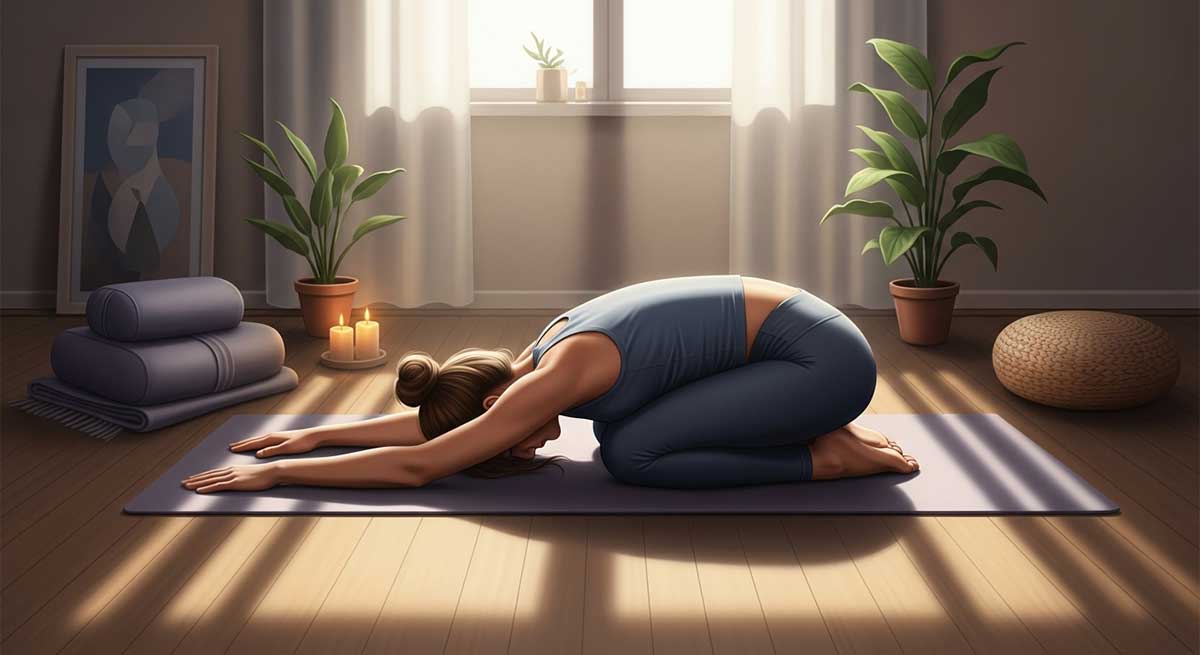
Why it works better than running:
While a 30-minute run floods your system with stress hormones (even the good kind), Child’s Pose does something different. It sends a direct signal to your vagus nerve – the highway between your brain and body that controls your relaxation response.
When your forehead touches the ground, it creates gentle pressure that activates pressure receptors under your skin. This triggers what scientists call the “dive response,” instantly slowing your heart rate and deepening your breath. It’s like nature’s panic button, but in reverse.
Breathing Pattern: Use 4-7-8 breathing (inhale for 4, hold for 7, exhale for 8) to amplify the calming effect.
How to do it for instant relief:
- Kneel on your mat with your big toes touching
- Sit back on your heels and spread your knees wide
- Fold forward, bringing your forehead to the ground
- Extend your arms in front of you or rest them alongside your body
- Begin 4-7-8 breathing pattern for 4 complete cycles
- Then breathe naturally for remaining time
Pro-Tip: Place a rolled-up blanket between your heels and glutes to ease any knee discomfort.
2. The “worry-washing” move that calms a scattered mind
Pose: Cat-Cow (Marjaryasana-Bitilasana)
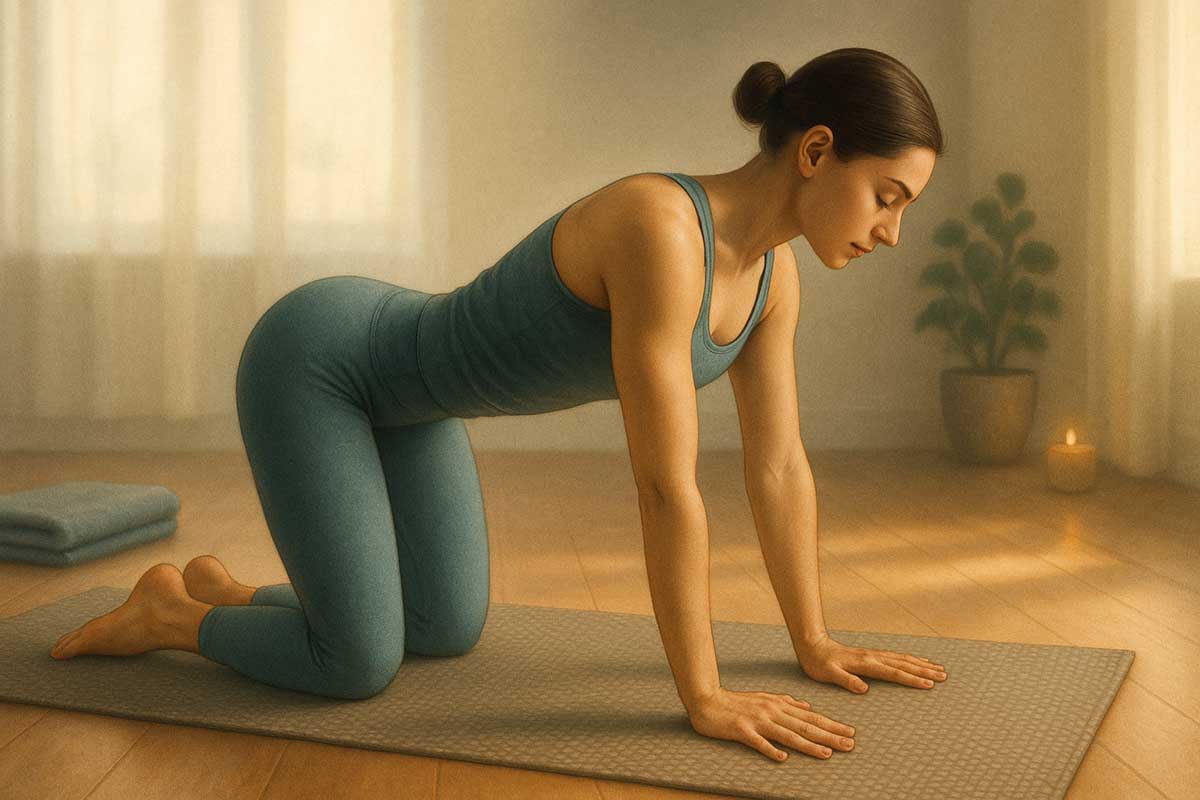
Why it works better than distraction:
Your anxious mind loves to time-travel – jumping between past regrets and future fears. Cat-Cow breaks this cycle by anchoring you in the present moment through synchronized movement and breath.
The gentle spinal flexion and extension massage your internal organs while the rhythmic nature mimics the soothing motion you experienced in the womb. Unlike trying to distract yourself with TV or scrolling, this movement actually rewires your brain’s attention networks.
Breathing Pattern: Natural breath rhythm, with each movement matching one breath cycle.
How to do it for instant relief:
- Start on your hands and knees in tabletop position
- Inhale, drop your belly down, and lift your chest and tailbone (Cow)
- Exhale, round your spine toward the ceiling, and drop your head (Cat)
- Continue for 8-10 breaths, moving slowly and smoothly
- Let each breath guide the movement
- End in neutral tabletop position
Pro-Tip: Close your eyes to deepen the meditative aspect of this movement.
3. The 60-second “tension tamer” for your shoulders and neck
Pose: Standing Forward Fold (Uttanasana) with Ragdoll Arms
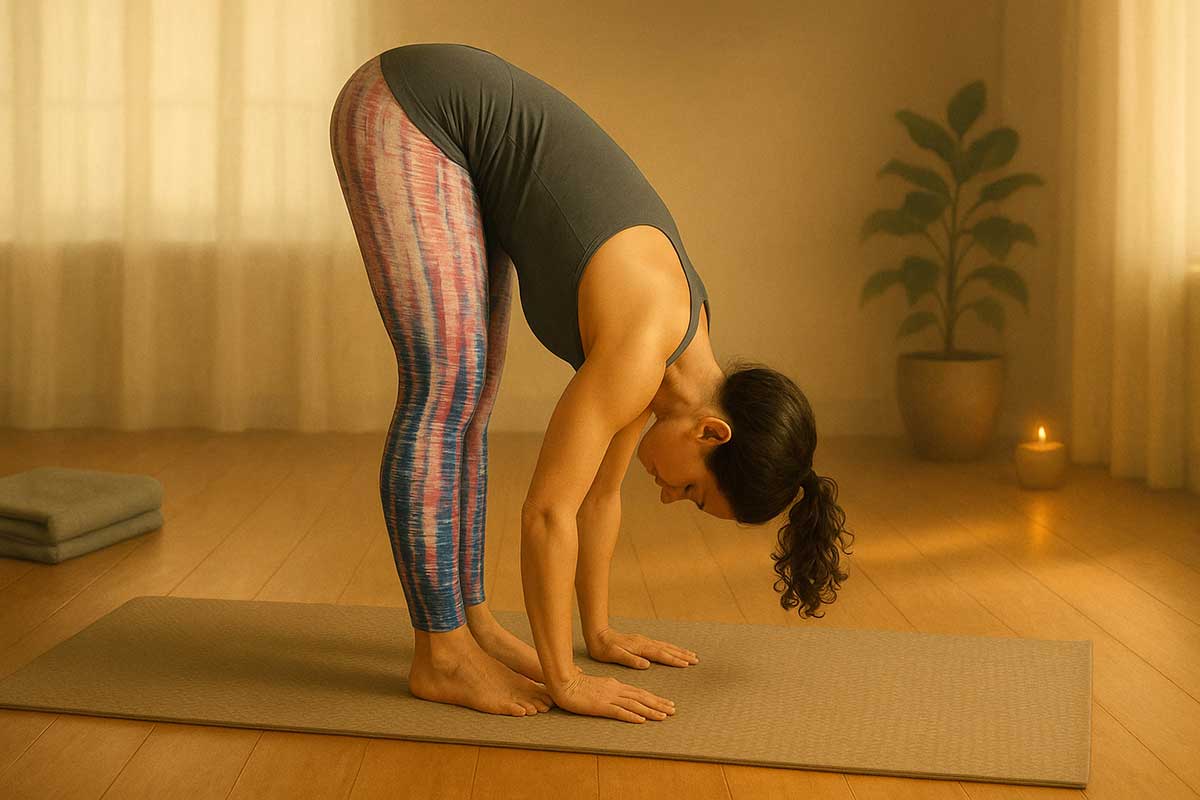
Why it works better than stretching alone:
Anxiety loves to live in your shoulders and neck, creating a fortress of tension that keeps stress locked in. This gentle inversion doesn’t just stretch those tight spots – it literally turns your perspective upside down.
The forward fold increases blood flow to your brain while the ragdoll arms create a natural traction that releases the deep muscles around your neck and shoulders. It’s like getting a massage from gravity.
Breathing Pattern: Extended exhale breathing (inhale for 4 counts, exhale for 8 counts).
How to do it for instant relief:
- Stand with your feet hip-width apart
- Hinge forward from your hips, keeping a generous bend in your knees
- Let your arms hang heavy like a ragdoll
- Begin extended exhale breathing pattern
- Grab opposite elbows and gently sway side to side
- Stay for 30-60 seconds, maintaining the breathing pattern
Pro-Tip: Gently sway from side to side to increase the release in your spine.
4. The “confidence-boosting” stance that quiets insecurity
Pose: Warrior II (Virabhadrasana II)

Why it works better than positive affirmations alone:
Anxiety often whispers lies about your strength and capability. Warrior II doesn’t just tell you you’re strong – it helps you feel it in your bones.
This pose creates what researchers call “embodied confidence.” When you physically take up space with purpose and strength, your brain receives feedback that you’re safe and capable. It’s like wearing a superhero costume that actually gives you superpowers.
Breathing Pattern: Box breathing (4-4-4-4 count) to maintain focus and strength.
How to do it for instant relief:
- Step your feet 3-4 feet apart
- Turn your right foot out 90 degrees, left foot in slightly
- Bend your right knee over your ankle
- Extend your arms parallel to the ground
- Begin box breathing pattern
- Gaze over your right fingertips with soft focus
- Hold for 30-60 seconds, then switch sides
Pro-Tip: Gaze confidently over your front fingertips to enhance the feeling of focus and determination.
5. The “instant calm” inversion that soothes a racing heart
Pose: Legs-Up-the-Wall (Viparita Karani)
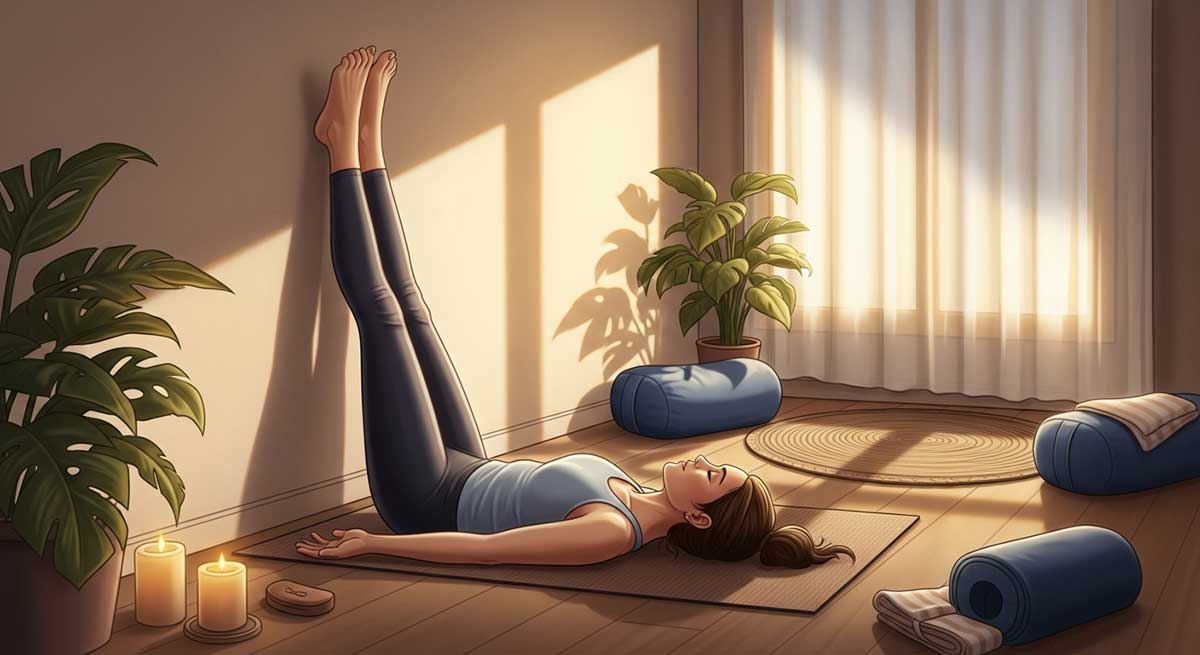
Why it works better than lying down flat:
When anxiety strikes, your heart rate spikes as if you’re running from a tiger. This gentle inversion works like a natural beta-blocker, slowing your heart rate without medication.
Elevating your legs above your heart improves venous return – the flow of blood back to your heart. This sends a signal to your brain that everything is okay, activating your body’s relaxation response. It’s like hitting the brakes on your racing pulse.
Breathing Pattern: Natural belly breathing with focus on lengthening each exhale.
How to do it for instant relief:
- Lie on your back near a wall
- Scoot your tailbone close to the wall
- Extend your legs up the wall
- Rest your arms by your sides, palms up
- Focus on natural belly breathing
- Allow each exhale to be slightly longer than your inhale
- Close your eyes and breathe naturally for 5-15 minutes
Pro-Tip: For a deeper sense of calm, place a weighted blanket over your torso.
6. The “mind-clearing” twist that releases stagnant energy
Pose: Supine Spinal Twist (Supta Matsyendrasana)
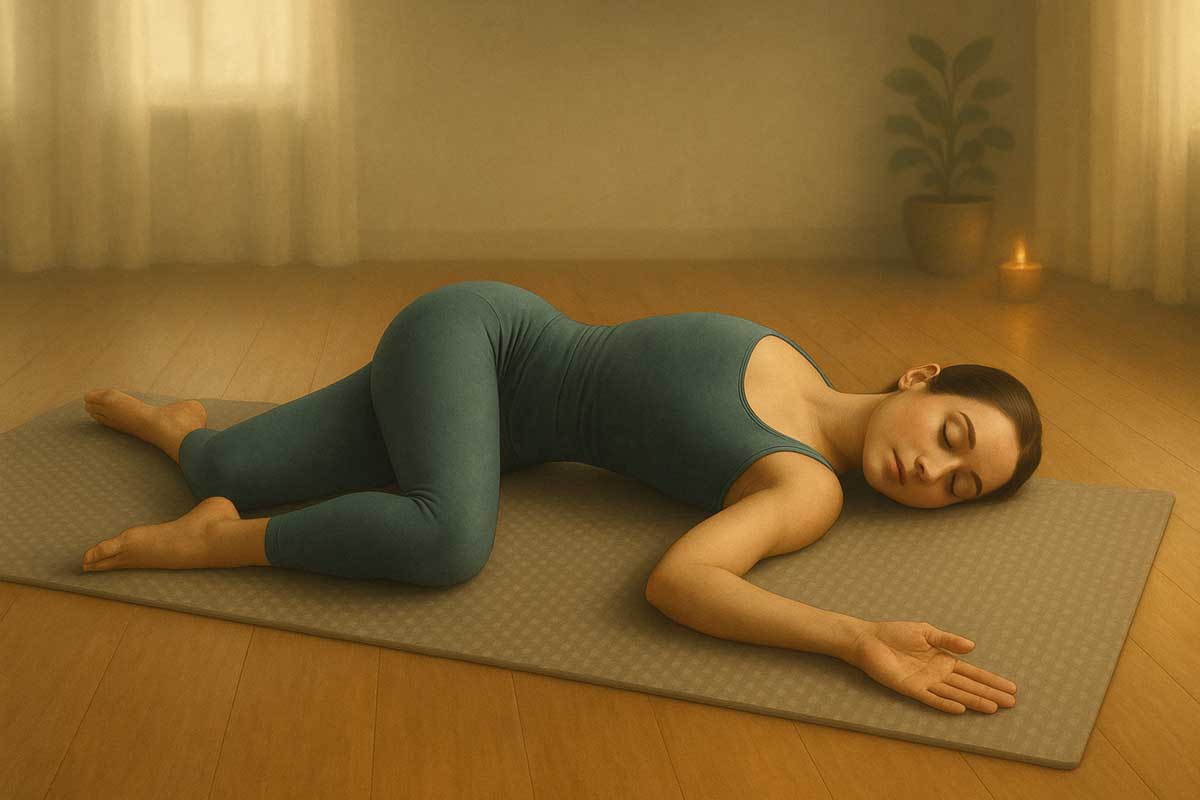
Why it works better than ignoring it:
Anxiety creates a traffic jam in your nervous system. Thoughts and emotions get stuck, circling endlessly without resolution. Spinal twists work like a gentle detox, helping to “wring out” that stagnant energy.
The twisting motion massages your internal organs while creating space between your vertebrae. It’s like opening windows in a stuffy room – suddenly, fresh energy can flow freely again.
Breathing Pattern: Natural breathing with emphasis on exhaling into the twist.
How to do it for instant relief:
- Lie on your back with your arms in a T-shape
- Draw your right knee to your chest
- Cross your right knee over to the left side of your body
- Keep your right shoulder grounded
- Turn your head to the right
- Breathe naturally, exhaling deeper into the twist
- Hold for 1-2 minutes, then switch sides
Pro-Tip: Allow your gaze to fall in the opposite direction of your knees for a deeper stretch.
7. The “ultimate unwind” pose for deep rest and relaxation
Pose: Corpse Pose (Savasana) with a Weighted Blanket
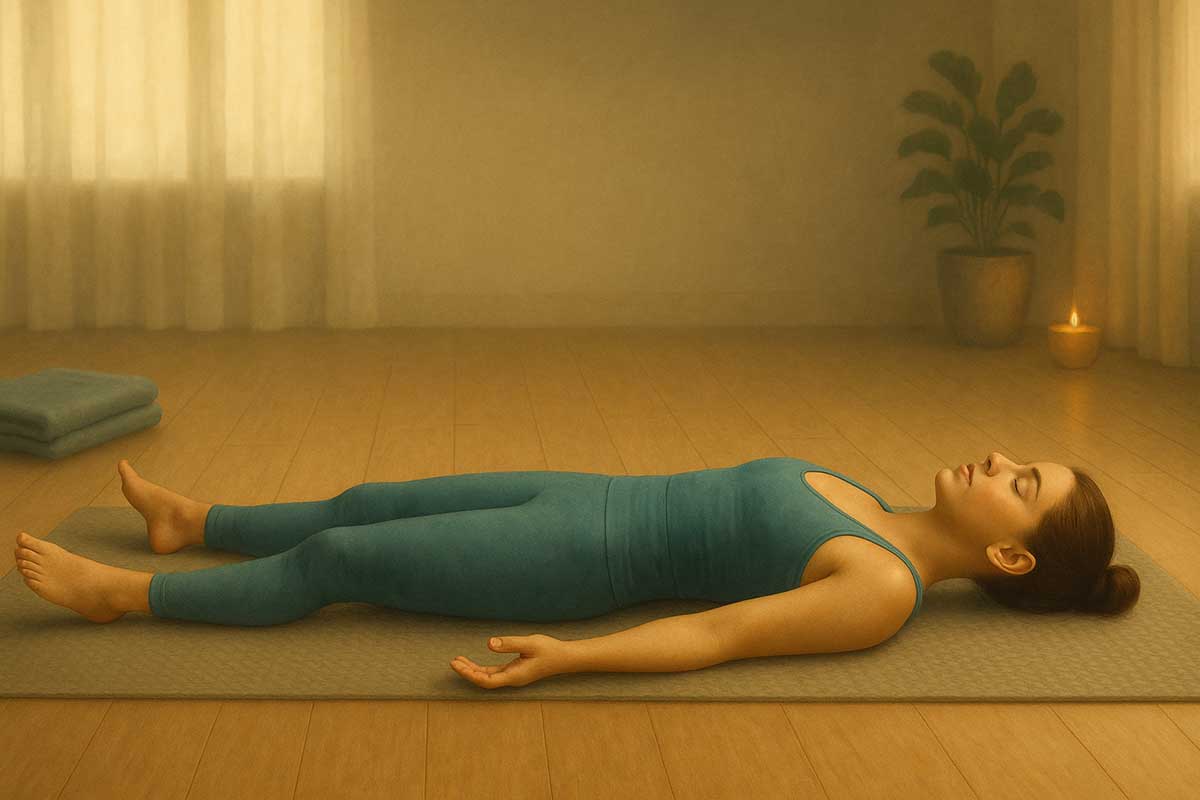
Why it works better than just going to sleep:
Sleep can be elusive when anxiety is high. Savasana offers something different – conscious relaxation that allows your nervous system to fully integrate the benefits of your practice.
The weighted blanket provides deep pressure stimulation, similar to being hugged. This pressure releases serotonin and dopamine while reducing cortisol levels. It’s like getting a neurochemical reset that prepares you for truly restorative rest.
Breathing Pattern: Natural breathing with body scan meditation.
How to do it for instant relief:
- Lie on your back with your legs extended
- Allow your feet to fall open naturally
- Rest your arms by your sides, palms up
- Cover yourself with a weighted blanket
- Close your eyes and begin natural breathing
- Scan your body from head to toe
- Release any tension you notice with each exhale
- Stay for 5-20 minutes
Pro-Tip: Create a calming environment with dim lighting and soothing music to enhance the experience.
Breathing techniques for specific anxiety symptoms
| Symptom | Technique | Pattern | Duration |
|---|---|---|---|
| Racing heart | 4-7-8 Breathing | Inhale 4, Hold 7, Exhale 8 | 4 cycles |
| Shallow breathing | Belly Breathing | Natural rhythm, focus on belly | 2-5 min |
| Panic attacks | Box Breathing | 4-4-4-4 count | Until calm |
| Overthinking | Extended Exhale | Inhale 4, Exhale 8 | 1-3 min |
| Tension | Lion’s Breath | Strong exhale with “ahh” sound | 3-5 breaths |
Ready-made practice sequences
| Time Available | Morning Sequence | Midday Reset | Evening Wind-Down |
|---|---|---|---|
| 5 minutes | Child’s Pose (2 min) Cat-Cow (1 min) 4-7-8 Breathing (2 min) |
Forward Fold (1 min) Warrior II (2 min each side) |
Legs-Up-Wall (5 min) |
| 10 minutes | Add Standing Forward Fold and brief Savasana |
Add Spinal Twist and Legs-Up-Wall |
Add Child’s Pose and extended Savasana |
| 20 minutes | Full sequence with extended holds |
Full sequence focusing on strength poses |
Full sequence with emphasis on restoration |
Safety first: when to modify or avoid
| Pose | Avoid If You Have | Modifications |
|---|---|---|
| Forward Fold | Lower back injury, high blood pressure | Keep knees bent, use blocks |
| Warrior II | Knee problems | Straighten front leg, use chair |
| Legs-Up-Wall | Serious heart conditions | Elevate head with pillows |
| Spinal Twist | Recent back surgery | Keep twists gentle, use props |
Common challenges & solutions
“My mind still races in Child’s Pose” Try counting breaths or humming softly. Racing thoughts are normal – acknowledge them and return to your breath.
“I can’t hold Warrior II” Use a wall for back support or shorten your holds. Build strength gradually over time.
“Legs-Up-Wall hurts my lower back” Place a pillow or bolster under your hips. You can also bend your knees slightly.
“I fall asleep in Savasana” That’s perfectly okay! Your body is getting the rest it needs. Set a gentle timer if needed.
“I don’t feel flexible enough” Yoga isn’t about flexibility – it’s about feeling better. Use props and modifications as needed.
“My anxiety gets worse during practice” This can happen as your body releases stored tension. Start with shorter sessions and consider working with a qualified instructor.
Anxiety management tools for daily life
Workplace anxiety solutions
Desk-friendly poses:
- Seated spinal twist (30 seconds each side)
- Shoulder rolls (5 backwards circles)
- Neck stretches (hold 15 seconds each direction)
- Seated forward fold (1 minute)
Discrete breathing methods:
- Box breathing during meetings
- Extended exhale before presentations
- Belly breathing at your desk
Social anxiety techniques
Before social events:
- 5 minutes of Child’s Pose
- Warrior II for confidence building
- 4-7-8 breathing for calmness
During social situations:
- Belly breathing (no one will notice)
- 5-4-3-2-1 grounding technique
- Excuse yourself for a bathroom break and do shoulder rolls
Sleep anxiety routine
1 hour before bed:
- Legs-Up-Wall (10 minutes)
- Gentle spinal twists (2 minutes each side)
- Child’s Pose (3 minutes)
- Savasana with weighted blanket (15+ minutes)
Travel anxiety kit
For small spaces:
- Seated spinal twists
- Ankle circles and calf raises
- 4-7-8 breathing
- Progressive muscle relaxation
Track your progress
Weekly check-in questions:
- How many days did I practice this week?
- What’s my average anxiety level (1-10 scale)?
- How’s my sleep quality?
- Which pose felt most helpful?
- What challenges came up?
Monthly goals:
- Week 1: Practice 3 days, focus on one pose
- Week 2: Practice 4 days, add breathing techniques
- Week 3: Practice 5 days, try longer sessions
- Week 4: Practice 6 days, include evening routine
Your next steps: building a sustainable practice
Week 1: Start small
- Choose one pose that feels good
- Practice for 5 minutes daily
- Focus on consistency over perfection
Week 2: Add breathing
- Include one breathing technique
- Extend practice to 8-10 minutes
- Notice how you feel before and after
Week 3: Create sequences
- Try the 10-minute morning sequence
- Add an evening wind-down routine
- Experiment with different poses
Week 4: Personalize your practice
- Focus on poses that help you most
- Adjust timing to fit your schedule
- Consider joining online classes for guidance
Conclusion
You now have seven powerful tools to calm your nervous system, specific breathing techniques for different situations, and ready-made sequences for any schedule. But here’s the real magic: you’ve learned that you have the power to change how you feel in your own body.
Anxiety might still visit, but it doesn’t have to stay. With just a few minutes of intentional movement and breath, you can shift from panic to peace, from scattered to centered, from overwhelmed to empowered.
The next time your mind starts racing, remember – you don’t need to run away from the feeling. Sometimes the fastest path to calm is simply rolling out your mat and coming home to yourself.
FAQs
How often should I practice?
Start with 5-10 minutes daily. Consistency matters more than duration. Even 2-3 times per week can provide significant benefits.
Can yoga replace anxiety medication?
Yoga is a powerful complement to traditional treatment but shouldn’t replace medication without consulting your healthcare provider.
What if I’m not flexible?
Flexibility isn’t required! Yoga meets you where you are. Use props, modify poses, and focus on how you feel rather than how you look.
How quickly will I see results?
Many people notice immediate relief from single sessions. For lasting changes, practice regularly for 2-4 weeks.
Is it normal to feel emotional during practice?
Absolutely. Yoga can release stored emotions. If feelings arise, breathe through them or take a break in Child’s Pose.
What if I don’t have time for a full practice?
Even one pose or 2 minutes of breathing can help. Quality matters more than quantity.


